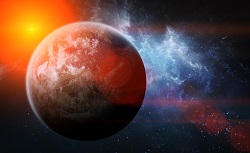Scientists search the stars for possible life
The existence of extra-terrestrial life presupposes the existence of habitable planets – like Earth – outside our solar system. What makes our own planet so special is the fact that it has a solid outer crust and is situated at a distance from the sun where liquid water can exist. Only a few other planets have ever been discovered which satisfy these ‘habitability’ criteria. Through pioneering new calibration strategies for detecting the tiniest variations in light waves from stars, the EU-funded WAVELENGTH STANDARDS project aims to help astronomers find new ‘habitable’ planets, and perhaps one day help us answer the question of whether we are truly alone in the universe. Star performance The five year project, due for completion at the end of 2016, has already recorded several achievements. ‘We have participated in several international, long-term projects with the instruments we have helped to develop and build,’ explains project coordinator Professor Ansgar Reiners from the Georg-August-Universität Göttingen, Germany. ‘These projects have involved the search for extrasolar planets and life elsewhere in the universe. Some discoveries have proved important for our understanding of planet formation, such as the planet we found orbiting Kapteyn's star.’ WAVELENGTH STANDARDS has also made a significant contribution to the CARMENES project, which built two spectrographs (instruments to measure wavelengths) with sensitivity extending into the infrared in order to search for Earth-like planets around low-mass stars. Reiners’ team was responsible for calibration, data reduction and analysis. ‘Another success has been our responsibility for calibration in the CRIRES+ project at ESO (European Southern Observatory)'s Very Large Telescope. Our group is also going to be in charge of the calibration unit for the design of the planned high resolution spectrograph for ESO's flagship project, the 39m E-ELT (European Extremely Large Telescope).’ Funding from the EU’s European Research Council (ERC) also enabled Reiners to carry out high precision experiments with local telescopes and couple them with state-of-the art frequency calibration methods (called laser frequency combs). ‘We were able to install all necessary equipment required for highest precision measurements in-house,’ adds Reiners. On the right wavelength In order to detect ‘habitable’ planets outside our solar system, extremely sensitive equipment is required. Minute, periodic changes in starlight must be identified, which indicate that the star is being orbited by a planet. Such investigations require ultra-precise light sources that can be used as reference points to allow the measurement of light wavelengths. For “cold” stars however – the type of stars that are closest to us – the calibrations required have until now simply not been available. ‘A small, Earth-like planet is detectable as a change in wavelength observed from a star; in other words, the star very slightly changes colour,’ explains Reiners. ‘This is why we need new wavelength standards that tell us at what particular wavelengths we are receiving from the starlight at any given time, and this is where our project promises to make a difference. Our group is now one of the few worldwide that can provide calibration strategies and facilities for the next generation of radial velocity spectrometers.’ For further information please visit: project coordinator website CORDIS project page
Countries
Germany



